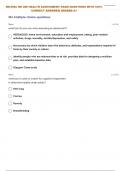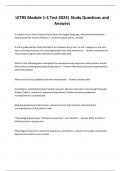Cognitive Behavior Therapy Correct
100%
Identify common attributes shared by all cognitive behavior approaches. - ANSWER All
of the cognitive behavioral approaches share the same basic characteristics and
assumptions as traditional behavior therapy. Although the approaches are quite diverse,
they do share these attributes: (1) a collaborative rela- tionship between client and
therapist, (2) the premise that psychological distress is often maintained by cognitive
processes, (3) a focus on changing cognitions to produce desired changes in affect and
behavior, (4) a present-centered, time-limited focus, (5) an active and directive stance
by the therapist, and (6) an educational treatment focusing on specific and structured
target problems
In addition, both cognitive therapy and the cognitive behavioral therapies are based on
a structured psychoeducational model, make use of homework, place responsibility on
the client to assume an active role both during and outside ther- apy sessions,
emphasize developing a strong therapeutic alliance, and draw from a variety of
cognitive and behavioral strategies to bring about change. Therapists help clients
examine how they understand themselves and their world and suggest ways clients can
experiment with new ways of behaving
To a large degree, both cognitive therapy and cognitive behavior therapy are based on
the assumption that beliefs, behaviors, emotions, and physical reactions are all
reciprocally linked.
CBT therapists apply behavioral techniques such as operant condi- tioning, modeling,
and behavioral rehearsal to the more subjective processes of think- ing and internal
dialogue. In addition, therapists help clients actively test their beliefs in therapy, on
paper, and through behavioral experiments. Cognitive therapy and the cognitive
behavioral approaches include a variety of behavioral strategies
Describe how the A-B-C model is a way of understanding the interaction among
feelings, thoughts, and behavior. - ANSWER rational emotive behavior therapy (REBT)
was the first of the cognitive behav- ior therapies, and today it continues to be a major
cognitive behavioral approach.A basic assumption of REBT is that people contribute to
their own psychological problems, as well as to specific symptoms, by the rigid and
extreme beliefs they hold about events and situations. REBT is based on the
assumption that cognitions, emotions, and behaviors interact significantly and have a
reciprocal cause-and-effect relationship.REBT is based on the premise that we learn
irrational beliefs from significant others during childhood and then re-create these
irrational beliefs throughout our life- time. We actively reinforce our self-defeating beliefs
through the processes of auto- suggestion and self-repetition, and we then behave in
ways that are consistent with these beliefs.
, The A-B-C framework is central to REBT theory and practice.This model provides a
useful tool for understanding the client's feelings, thoughts, events, and behavior
A-is the existence of an activating event or adversity, or an inference about an event by
an individual
B-is the person's belief about A, largely creates C, the emotional reaction.
C-s the emotional and behavioral conse- quence or reaction of the individual; the
reaction can be either healthy or unhealthy. A (the activating event) does not cause C
(the emotional consequence).
D-After A, B, and C comes D (disputing). Essentially, D encompasses methods that
help clients challenge their irrational beliefs. There are three components of this dis-
puting process: detecting, debating, and discriminating. Clients learn to discriminate
irrational (self-defeating) beliefs from rational (self-helping) beliefs (
E-a new effective philosophy, which also has a practical side. A new and effective belief
system consists of
Understand how cognitive methods can be applied to change thinking and behavior.
Also what is rational emotive imagery (rei)?
Behavioral Techniques? - ANSWER REBT practitioners usually incorporate a
persuasive cognitive methodology in the therapeutic process. They demonstrate to
clients, often in a quick and direct manner, what it is that they are continuing to tell
themselves. Then they teach clients how to challenge these self-statements so that they
no longer believe them, encouraging them to acquire a philosophy based on facts.
REBT relies heavily on thinking, disputing, debating, challenging, interpreting,
explaining, and teaching. The most efficient way to bring about lasting emotional and
behavioral change is for clients to change their way of thinking (A. Ellis & Ellis, 2011,
2014). Here are some cognitive techniques available to the therapist
Disputing irrational beliefs. The most common cognitive method of REBT consists of the
therapist actively disputing clients' irrational beliefs and teaching them how to do this
challenging on their own. Clients dispute a particular "must," absolute "should," or
"ought" until they no longer hold that irrational belief, or at least until it is diminished in
strength. Here are some examples of questions or statements clients learn to tell
themselves when they dispute their irrational ideas: "Why must people treat me fairly?"
"How do I become a total flop if I don't succeed at important tasks I try?" "If I don't get
the job I want, it may be disap- pointing, but I can certainly stand it." "If life doesn't
always go the way I would like it to, it isn't awful, just inconvenient."







